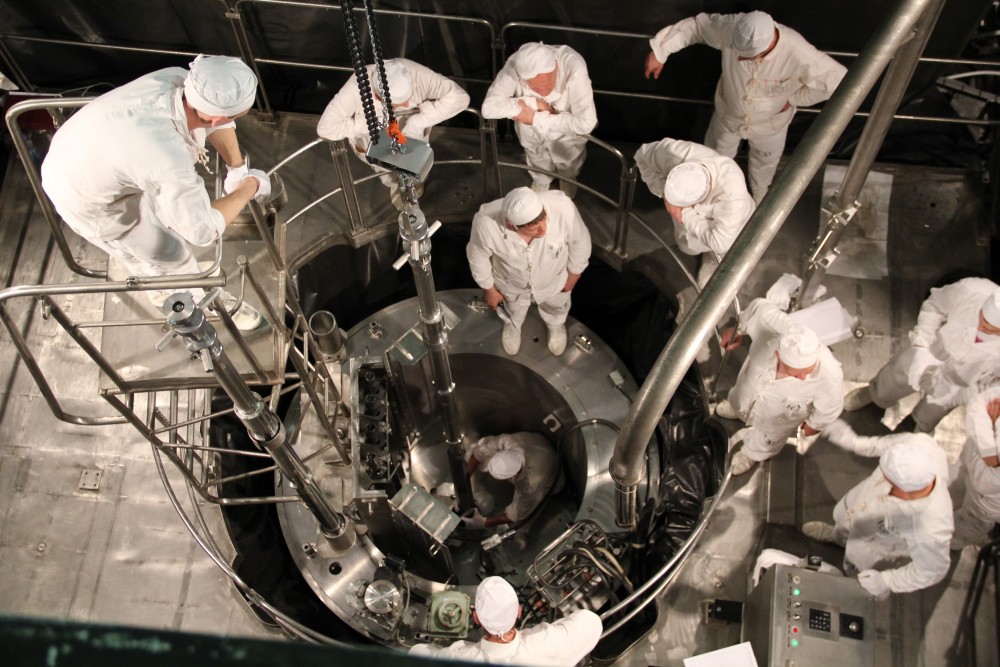Russia’s state nuclear corporation Rosatom has begun offering to build floating nuclear plants for a number of foreign countries, the official Tass newswire has reported, citing government statements.
Russia’s state nuclear corporation Rosatom has begun offering to build floating nuclear plants for a number of foreign countries, the official Tass newswire has reported, citing government statements.
Though the exact list of proposed customers remains unknown, it has long been one of Rosatom’s hopes to capitalize on the experience of the controversial Akademik Lomonosov, Moscow’s first floating nuclear power plant, which began producing electricity for its remote Siberian port a year ago this month. It entered full commercial service in May, supplying 70 megawatts of power to the Chukotka region, across the Bering Strait from Alaska.
“Rosatom has made proposals for the installation of floating units to a number of foreign countries,” Yury Trutnev, a deputy prime minister and presidential representative to Russia’s Far Eastern Federal District, said earlier this month, according to Tass. “It’s clear that one unit is not enough for us to sell such modules. Their future replication would open a possibility for Russia to open a market niche where there currently is no one.”
The Akademik Lomonosov, has long been discussed by Rosatom as a commodity Moscow is anxious to sell abroad. But the plant’s multi-million-dollar price tag, coupled with a protracted construction effort that lasted more than a decade, has made the idea hard to sell.
Yet, ever since the Akademik Lomonosov and its two KLT-40S reactors left the Baltic Shipyard in 2019, Rosatom officials have touted the notion of developing a more streamlined version of the hulking nuclear barge for foreign buyers. Trutnev’s statements last week, coupled with other recent reports in Russian media, offer a clearer picture of what that effort would look like.
On Monday, the semi-official RIA Novosti reported on the so-called “optimized floating nuclear plant,” the draft designs for which were unveiled by Atomenergomash, Rosatom’s construction wing, at an engineering conference in St Petersburg.
Compared to the 140-meter-long Akademik Lomonosov, the optimized plant would be structurally simpler and easier to reproduce on mass scale, said Andrey Nikipelov, the general director of Atomenergomash’s machine building division.
It would also be more powerful, Nikipelov said, relying on two modernized RITM-200 reactors, the type that powers Russia’s new generation nuclear icebreakers, instead of the KLT-40. That would increase its output to 100 megawatts – a 30 megawatts increase on what is supplied by the Akademik Lomonosov.
Nikipelov also said the new design would solve a major flaw in the Akademik Lomonosov, which has long worried environmental organizations, including Bellona. Every 12 years, the Lomonosov has to be towed back to Murmansk to offload spent nuclear fuel. The optimized design features a removable spent fuel storage module, allowing reactors to remain in place for refueling operations
Crews on the optimized version would also be quartered onshore, unlike the Akademik Lomonosov, which features dormitories and recreation facilities for about 70 resident crew members. In all, the scaled-down plant would have a reduced water displacement of 18,700 tons – some 4,000 tons less than the Akademik Lomonosov.
While it remains unclear precisely which countries Rosatom has approached, the company has long claimed that unspecified governments in North Africa, the Middle East and Southeast Asia are interested in acquiring floating nuclear plants. Tass also reported that Rosatom was in talks with Cuba about both land-based and floating reactors.
Bellona has opposed Russia’s aspirations to build floating nuclear plants since the Akademik Lomonosov’ construction began in 2006, and has published a detailed catalogue of its concerns in a report it released in 2011.




